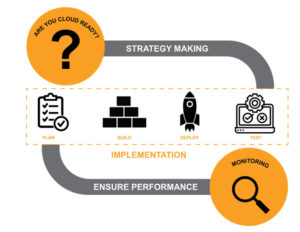Government agencies and commercial enterprises are increasingly moving to the cloud to realize benefits such as availability, reliability, scalability, and, when done correctly, affordability. A key challenge they face is that the government has missions, standards, and protocols markedly different from commercial space
As a paradigm, cloud computing fundamentally alters the art and science of online business and represents a profound transformation in IT infrastructure. It enables the organizations to operate efficiently, provides scalability responsiveness, and drives growth and revenue.

Core-CSI works with our clients to assess the suitability for the Cloud, help them choose the precise platforms and assist them to put their best foot forward. Our key strengths are enabling our customers to analyze cloud readiness quotient and adopt cloud technologies through well-defined maturity models. We have a proven track record of successful IT implementations. We help our customers effectively utilize existing Computing Resources, analyze ROI on cloud adoption, reduce Data Center Space Utilization, Centralized Management & Upgrades and Faster Deployments of solutions into Cloud.
Virtual desktop infrastructure (VDI) is a virtualization technology that hosts a desktop operating system on a centralized server in a data center. VDI is a variation on the client-server computing model, sometimes referred to as server-based computing.



